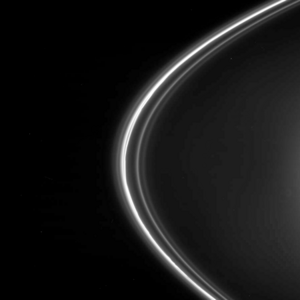Shepherd moon facts for kids
A shepherd moon is a small natural satellite that helps keep a planet's rings neat and tidy. Think of it like a sheepdog herding sheep! These moons either clear a space in the ring material or stop the ring particles from spreading out.
Shepherd moons use their gravity to pull on the tiny pieces that make up a planet's rings. This pull changes the paths of the ring particles. This is how they create clear gaps in the rings, like the famous Cassini Division in Saturn's rings. They can also create interesting patterns or even "twisted" shapes in the rings.
Contents
How We Found Them
Scientists first thought about shepherd moons in 1979. They noticed that the rings around Uranus were very thin and had clear spaces between them. To explain this, two scientists, Goldreich and Tremaine, guessed that two small moons, which hadn't been seen yet, were keeping each ring in place. Later that year, the Voyager 1 spacecraft took the first pictures of these amazing shepherd moons.
Examples in Our Solar System
Jupiter's Rings
Jupiter has a ring system, and some of its small inner moons, like Metis and Adrastea, are inside these rings. These moons are also very close to Jupiter, within its Roche limit. This means Jupiter's strong gravity is pulling material off these moons. Scientists think this material might be what forms Jupiter's rings, possibly helped by small impacts on the moons' surfaces.
Saturn's Rings
Saturn is famous for its many beautiful rings. It has several shepherd moons that help shape them. For example:
- Prometheus helps control Saturn's F ring.
- Daphnis keeps the Keeler Gap clear.
- Pan is found in the Encke Gap.
- Janus and Epimetheus both influence Saturn's A ring.
Uranus's Rings
Uranus also has shepherd moons. Cordelia and Ophelia are two of them, working with Uranus's ε ring. Cordelia is an "inner" shepherd, and Ophelia is an "outer" shepherd. Both moons are slowly getting closer to Uranus over time because of the planet's gravity pulling on them.
Neptune's Rings
Neptune's rings are quite unusual. From Earth, they first looked like they were made of broken arcs, not complete rings. But when Voyager 2 flew by, it showed that they are full rings with bright clumps of material. Scientists believe that the gravity of the shepherd moon Galatea, and maybe other moons we haven't found yet, cause these clumps.
Rings Around Minor Planets
It's not just big planets that have rings! Some small objects called centaurs also have them.
- Chariklo has very clear rings. Scientists think these rings are either very new or are kept in place by a shepherd moon that is similar in size to the rings themselves.
- Chiron is another centaur that is thought to have rings, similar to Chariklo's.
See also
 In Spanish: Satélite pastor para niños
In Spanish: Satélite pastor para niños



